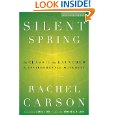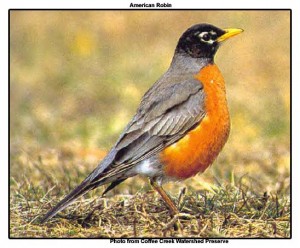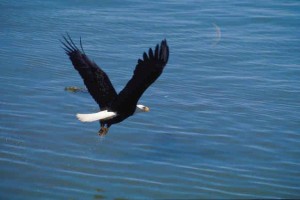In 1962 with a formal background in biology, countless publications for the Bureau of Fisheries and the US Fish and Wildlife Service, Rachel Carson added to her volumes of work Silent Spring
, arguably the most enduring, controversial, and legendary books of the modern Sustainability Era.
Doubting her ability to find a magazine willing to publish a single article on the pessimistic topic of the effect of chemicals on the environment, Carson decided instead to produce a full length book. Serialized in the New Yorker (desribed at the NRDC) prior to the 1962 publication, Silent Spring
quickly became the focus of incredible public attention. Coupled with this growing attention, the chemical industry responded to Silent Spring with a focused quarter-million-dollar campaign aiming to discredit Carson. Despite the concerted effort by the chemical industry, a Presidential commission began looking into the issues – and Congress began considering tougher restrictions on chemicals. (Carson testified before Congress.)
Poignantly, Silent Spring is essentially a survey of research on pesticides, begins artistically with a story depicting a town having suffered a series of plagues. At the end of this chapter, Carson tells us that the town is fictitious, however, she adds that each of the events recounted “has actually happened somewhere.”
Lending substance to the original story, Carson goes on to describe the source of the plagues as newly designed man-made chemicals applied in massive quantities almost everywhere. In doing this Carson introduces the singular analogy that runs through Silent Spring: “pesticides are like atomic radiation—invisible, with deadly effects that often manifest themselves only after a long delay.” Further, she identifies the qualities that are increasing the danger of these new chemicals/pesticides over their predecessors:
- Greater chemical potency
- Slower breakdown and decomposition of the chemicals
- A tendency for the chemicals to become concentrated in fatty tissue.
For Carson, it is also important to note that while a toxin may not constitute a severe danger in limited exposure and dose, danger occurs with ultimate accumulation in the body, and concentration up the food chain.
Carson also takes the time to stress the innate interconnectedness of life in the three biological systems of plant, water and soil. Water, for instance, is a difficult system to contain a problem given its fluid state and interconnectedness to the other states. Carson goes on to point out that due to the very tangible result of runoff and agricultural spraying, groundwater nearly everywhere is tainted with one or more toxins. Carson goes on to note that the nature and full extent of the chemical problem is that it cannot be precisely measured due to a lack of precise screening methods. Further, she explains the life cycle of soil-based ecosystems: elaborating that healthy soil gives rise to healthy plant life with the natural process of death and decay breaking down plants, and restoring life to the soil. Chemicals threaten this dynamic not only for plants, but also for the higher organisms living on plants.
Throughout the early chapters a general picture emerges. A picture of the systematically deceptive chemical industry practices, coupled with ill-informed governments. Together these two groups spend huge amounts of taxpayers’ money destroying entire ecosystems in an effort to eradicate one or two nuisance species.
Later attention turns to the people behind pesticides and the public officials responsible for the widespread use of these chemicals. In Carson’s view, the irresponsible behavior is highlighted by an irrational unwillingness to recognize and acknowledge their far reaching and long lasting effects.
At the heart of Silent Spring, is the profound Chapter called “And No Birds Sing,” depicting stories – and providing the lasting imagery that is Silent Spring. The focus here is DDT, and the two primary victims are the robin and the eagle. As an illustration of the chain-like biological effects Carson noted earlier, these victims help illustrate and explain bio-magnification. Bio-magnification simply stated is the way toxins pass from organism to another the organism along the food chain:
- The robin consumes fatal doses of chemicals by eating poisoned worms and insects tainted by pesticide spraying, and
- The eagle receives fatal doses from pesticide-carrying fish tainted by runoff and groundwater contamination.
Tucked within the chapters throughout the book are countless examples and accounts of chemical industry abuses. These abuses go on to illustrate the far reaching grasp of the chemicals on the environment, and consequently on human life. In this light it is easy to understand the scope Carson seeks to illustrate. The chapters successfully lay out the unquestionable view that unless you are lucky enough to be in an extremely isolated region of the globe, there is a very real concern that you have been touched by repeated exposures to chemicals. Carson directly lays the blame for this massive diffusion of dangerous chemicals on both the chemical companies and the government. Companies, on one hand have practiced deceptive marketing campaigns insisting products are safe, and government agencies on the other hand (a-la the FDA) continue disinformation and active promotion of chemical use.
Carson also notes safer alternatives, and concludes with an explanation of what ‘‘biotic controls.’’ By doing this, Carson effectively takes away the chemical companies ability to stand on their feet. Carson explains that although one of the chief arguments used by the chemical industry is that risks are justified by benefits to life. However, in the chapter on biotic controls, she systematically lays out details for cheaper, safer, and more effective alternatives to toxic chemicals.
While at the time of publication, mainstream media looked at Carson’s work as potentially being something blown out of proportion, since the publication of Silent Spring in 1962, forty-seven years of scientific research has confirmed virtually all of the book’s major claims. In addiion, beyond strict scientific validification, historically speaking, the importance of Silent Spring to the modern environmental movement cannot be overlooked. Without Rachel Carson’s ground breaking work calling attention to the effects of man on the environment; the changes in laws, social and civil rights, production practices, business and global accountability may not have been able to progress the way they have. Craig Waddell offered a concise assessment of the truly historic significance and nature of this book:
“Ernest Hemingway once wrote that ‘All modern American literature comes from one book by Mark Twain called Huckleberry Finn.’ It would not be too much of an exaggeration to make a similar claim for Silent Spring‘s relationship to the modern environmental movement. Although the American environmental movement traces its roots to such nineteenth-century visionaries as Henry David Thoreau, George Perkins Marsh, and John Muir—all of whom were concerned with the preservation of the wilderness—the modern environmental movement, with its emphasis on pollution and the degradation of the quality of life on the planet, may fairly be said to have begun with one book by Rachel Carson called Silent Spring.”
—


